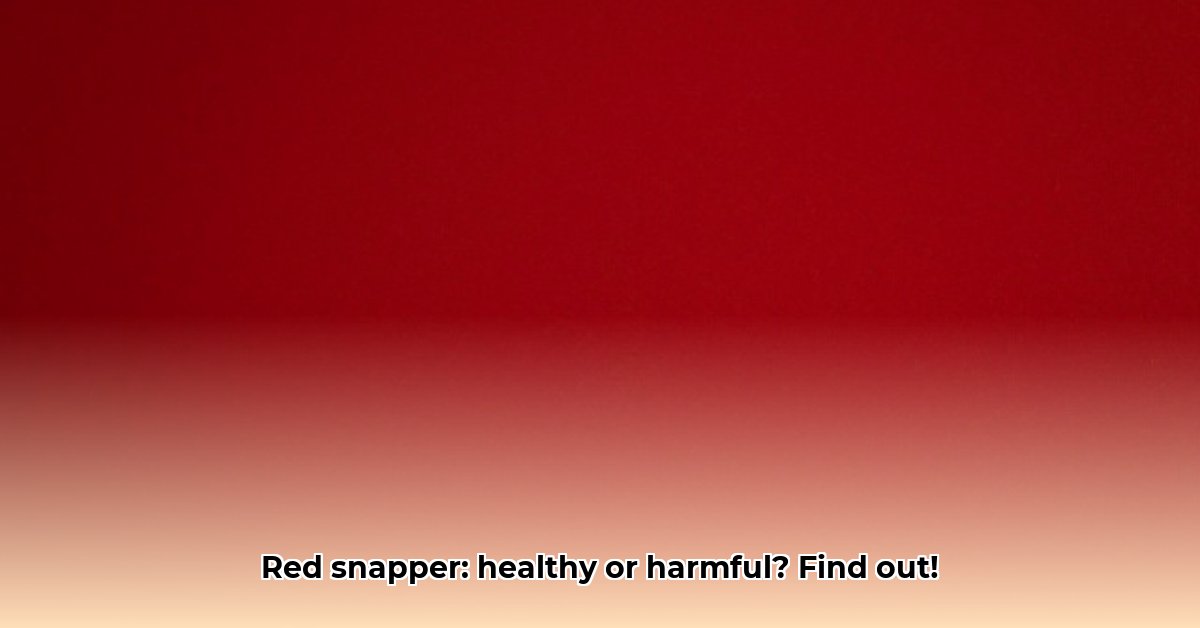Love red snapper? It’s delicious, but is it good for you? We’ll lay it all out: the good, the bad, and how to make sure you’re getting the healthiest, most sustainable red snapper possible. This guide covers everything from nutrition facts and mercury levels to choosing the right fish and avoiding misleading labels. We’ll even compare it to other fish, like pollock, so you can make the best choice for your meals and the planet. Let’s make sure your seafood choices are as yummy as they are healthy!
Red Snapper’s Health Profile: Benefits and Risks
So, you’re wondering if red snapper is a good choice for your dinner plate? It’s a delicious fish, but like anything, there’s more to the story than just taste. Let’s dive into the good, the bad, and the fishy bits.
The Nutritional Advantages of Eating Red Snapper
Red snapper is packed with nutrients that are good for you. It’s a fantastic source of lean protein, which is essential for building and repairing tissues. A 6-ounce serving provides approximately 35 grams of protein, crucial for muscle development and overall bodily functions. Plus, it’s brimming with omega-3 fatty acids – those healthy fats that are great for your heart, acting as tiny bodyguards protecting your cardiovascular system. Omega-3s, specifically EPA and DHA, help reduce inflammation and lower the risk of heart disease. You’ll also find a good dose of vitamins, like B12 (important for nerve function) and D (for strong bones), along with minerals such as selenium, a powerful antioxidant that supports thyroid and immune health. Basically, it’s a nutritional powerhouse, contributing to your overall well-being.
However, remember what your grandma always said – everything in moderation! The American Heart Association recommends eating fish, particularly fatty fish like salmon or mackerel, at least two times a week. Red snapper can definitely be one of those choices. But how does mercury content come into play with these health benefits of red snapper?
Understanding Mercury Levels in Red Snapper
While red snapper offers many health benefits, it’s important to be aware of potential mercury contamination. Mercury is a naturally occurring element, but unfortunately, it can accumulate in fish, including red snapper. It’s present in the environment and can be absorbed by fish as they feed. While usually not a huge concern for most adults, high levels of mercury can be harmful, especially for pregnant women, nursing mothers, and young children. These groups are more vulnerable to the negative effects of mercury, which can impact brain development and other crucial body functions. Therefore, it’s wise for them to limit their red snapper consumption.
The FDA (Food and Drug Administration) provides guidelines for fish consumption based on mercury levels. Red snapper is generally considered a “good choice,” which means the FDA recommends eating one serving a week. It’s always best to check the most current FDA recommendations. Your local health department or the FDA (Food and Drug Administration) often publishes advisories about mercury levels in local seafood, so check those before stocking up.
Sustainability Issues: Is It Real Red Snapper?
Now, for the environmental side of things. Sadly, many red snapper populations are struggling due to overfishing. Overfishing occurs when fish are caught faster than they can reproduce, leading to a decline in their numbers. The demand is high, and sometimes, fishing practices aren’t sustainable. This means that some fishing methods damage the ocean ecosystem and may deplete red snapper populations, threatening their long-term survival. Bottom trawling, for example, can destroy habitats on the ocean floor. It’s a bit like taking too many cookies from the jar; eventually, the jar will be empty! But what measures are being taken to counter unsustainable fishing of red snapper?
Recognizing Sustainable Fishing Methods and Eco-Labels
But there’s good news! Many organizations are working hard to promote sustainable fishing practices. Choosing responsibly sourced fish makes a difference! Look for certifications like the Marine Stewardship Council (MSC) label – it’s a little badge of honor that tells you the fish was caught using environmentally friendly methods. This ensures you’re contributing to protecting red snapper populations for future generations.
Sustainable fishing methods include hook-and-line fishing, which minimizes bycatch, and responsible aquaculture practices. These methods help maintain healthy fish populations and protect marine habitats.
The Truth About Seafood Labeling Practices
Here’s a frustrating fact: seafood mislabeling is surprisingly common. Studies have shown that a significant percentage of seafood is mislabeled, meaning the fish you’re buying isn’t what the label says. Because red snapper is a popular and often expensive fish, there’s a temptation to substitute it with cheaper varieties like tilapia or other snapper species. This means you might think you’re buying red snapper, but you’re actually getting something else entirely.
Always buy from reputable vendors who are transparent about their sources. Don’t hesitate to ask questions about where the fish comes from and how it was caught. A trustworthy fishmonger will be happy to answer your questions and provide you with this information.
Safe Consumption Guide: Enjoying Red Snapper Responsibly
So, how can you enjoy this delicious fish without the worries? Here’s a practical guide:
- Choose Wisely: Select sustainably sourced red snapper whenever possible. Look for those eco-labels! The Marine Stewardship Council (MSC) and Aquaculture Stewardship Council (ASC) are two reliable certifications.
- Moderation is Key: Limit your red snapper consumption to 1-2 servings per week. This is especially important for pregnant women and young children. The FDA recommends one serving a week for the general population.
- Know Your Source: Buy your red snapper from reputable fishmongers or supermarkets with transparent sourcing policies. Don’t be shy; ask about the origin and fishing methods.
- Scrutinize Labels: Carefully read labels to avoid any sneaky substitutions. Look for the scientific name ( Lutjanus campechanus ) to ensure you’re getting real red snapper.
- Stay Informed: Keep an eye out on updates and advisories from the FDA and other related health agencies regarding mercury levels and fishing guidelines in your area.
Quick Guide: Pros and Cons of Eating Red Snapper
| Feature | Pros | Cons |
|---|---|---|
| Nutritional Value | Excellent source of protein, omega-3 fatty acids, vitamins, and minerals | Potential mercury contamination, especially in larger fish. |
| Sustainability | Some sustainably managed fisheries are available. | Overfishing and destructive fishing practices threaten many populations. |
| Taste and Texture | Delicious mild flavor, flaky texture, versatile cooking possibilities. | Can be expensive and is prone to mislabeling. |
| Overall Health Impact | Contributes to a healthy diet (in moderation) | Potential health risks linked to mercury and unsustainable fishing practices. |
Remember, responsible consumption means being informed and making conscious choices. By carefully weighing the benefits and risks, you can enjoy delicious red snapper while also supporting sustainable fishing practices and prioritizing your health. Enjoy!
Identifying Sustainably Sourced Red Snapper: Reduce Overfishing
Key Takeaways:
- Red snapper offers nutritional benefits but sustainability concerns exist.
- Overfishing and mislabeling are significant issues.
- Choosing sustainably sourced red snapper protects marine ecosystems.
- Certifications like MSC and ASC help identify responsible choices.
- Limiting red snapper consumption promotes responsible seafood choices.
The Snapper Situation: Balancing Taste and Responsibility
Red snapper is a delicious fish, prized for its firm texture and delicate flavor. But like many popular seafood choices, its popularity poses challenges to its sustainability. Overfishing has historically depleted red snapper populations, impacting both the environment and the fishing industry. This is why learning how to identify sustainably sourced red snapper is crucially important. With this in mind, what specifically makes seafood sustainable?
Sustainable seafood comes from sources, whether fished or farmed, that can maintain or increase production in the long term without jeopardizing the health of the ecosystems from which they are harvested. This includes considering the impact on other species, habitats, and the communities that depend on fishing.
Protecting Ocean Ecosystems Through Sustainable Seafood Choices
Sustainable fishing practices are vital to preserving ocean health. Unsustainable practices damage marine habitats and harm other marine life through bycatch (unintentional capture of non-target species). Bottom trawling, for example, is a destructive method that negatively affects the ocean floor.
Choosing sustainable seafood helps to protect biodiversity, maintain healthy ecosystems, and support the livelihoods of fishing communities. It also ensures that future generations can enjoy the benefits of seafood.
Important Note: Balancing Benefits and Risks of Snapper
Red snapper is a good source of protein and certain vitamins. However, like other predatory fish, it can contain mercury. While mercury levels are generally low, they’re a concern, especially for pregnant women and young children. Moderation is key.
Consumer Guide: Selecting Sustainable Snapper
Here’s how you can make informed choices:
- Look for Certifications: The most reliable way to identify sustainably sourced red snapper is to look for certifications from organizations like the Marine Stewardship Council (MSC) or the Aquaculture Stewardship Council (ASC). These certifications indicate that the product was harvested using environmentally responsible methods.
- Ask Questions: Don’t hesitate to ask your fishmonger or restaurant about the origin and fishing method of their red snapper. Learn where it’s from and inquire about their sustainability practices, ensuring more responsible consumption.
3.
- Why Glass Boxes for Lunch Are Trending for Meal Prep - December 17, 2025
- Bento Box Glass Offers Practical, Eco-Friendly Meal Storage - December 16, 2025
- The Best Bento Box Price For Your Perfect Packed Lunch - December 15, 2025










